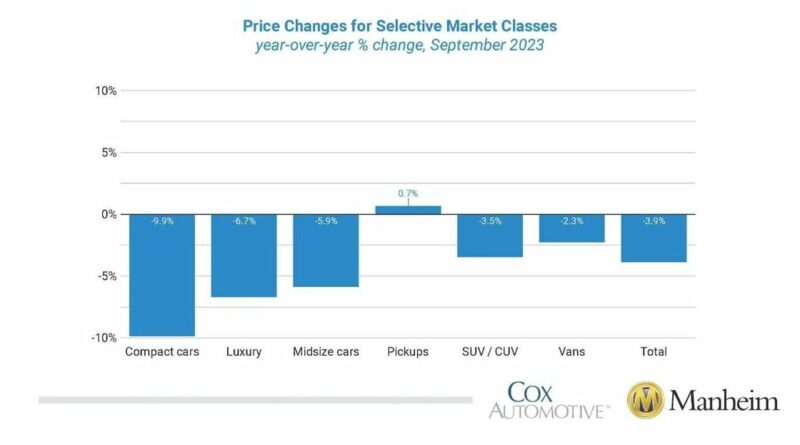Wholesale Used-Vehicle Prices Increase in September
The major market vehicle segments saw seasonally adjusted prices that were mostly lower year over year in September. Compared to September 2022, vans and SUVs lost less than the industry.
Graphic: Cox Automotive
Wholesale used-vehicle prices (on a mix, mileage, and seasonally adjusted basis) increased 1% in September from August, according the Manheim Used Vehicle Value Index (MUVVI) released Oct. 6, which rose to 214.3, down 3.9% from a year ago.
“September auction sales bolstered prices through the channel,” said Chris Frey, senior manager of economic and industry insights for Cox Automotive, in a news release. “While there was a bit of an acceleration from August, we shouldn’t get ahead of ourselves heading into the late fall and winter period. We are at a crossroads for wholesale, mainly from concerns about the UAW strike’s potentially slowing new retail sales and moving buyers into the used market. We don’t see that happening just yet, as it always takes time for changes to work through the market."
Frey said two very different outcomes are possible:
"While we have some modest changes built into our MUVVI forecast, we think the market mainly reflects balance at this point, relative to what we have been seeing for much of the last three years," Frey said. "We typically see only slight upward trends in wholesale values in the fourth quarter, which is why are forecasting our Used Vehicle Value Index to finish down 2.2% for the year."
The seasonal adjustment contributed to September’s increase. The non-adjusted price in September increased by 0.1% compared to August, moving the unadjusted average price down 5.4% year over year.
In September, Manheim Market Report (MMR) values saw below-average weekly declines to start the month; but the month ended with normal declines in the final week. Over the last four weeks, the Three-Year-Old Index declined an aggregate of 1.2%. Those same four weeks delivered an average decline of 1.8% in the years 2014–2019. During September, daily MMR Retention, which is the average difference in price relative to the current MMR, averaged 99.2%, meaning market prices were slightly below MMR values.
The average daily sales conversion rate declined to 55.7%, which was close to normal for the time of year. For comparison, the daily sales conversion rate averaged 55.3% in September 2019. The sales conversion rate in September was lower than in August but stronger than in June and July.
The major market segments saw seasonally adjusted prices that were mostly lower year over year in September. Compared to September 2022, vans and SUVs lost less than the industry, down 2.3% and 3.5%, respectively. Compact cars again performed the worst year over year, down 9.9%, followed by luxury down 6.7% and midsize cars down 5.9%. Pickups were up 0.7%, better than the industry and the only positive year-over-year performer. Compared to last month, pickups, midsize cars, compact cars, and SUVs gained more than the industry at 2.1%, 1.4%, 1.3%, and 1.1%, respectively. Luxury lost 0.6% and vans were down 0.9% from August.
Used Retail Vehicle Sales Decreased in September
Assessing retail vehicle sales based on observed changes in advertised units tracked by vAuto, Cox estimates that used-vehicle retail sales in September were down 10% compared to August, and the year-over-year comparison with 2022 worsened. Used retail sales are estimated to be down 2% year over year in September, which was the worst performance since June. The average retail listing price for a used vehicle moved down 0.7% over the last four weeks.
Using estimates of used retail days’ supply based on vAuto data, an initial assessment indicates September ended at 47 days’ supply, down two days from 49 days at the end of August and seven days lower than how September 2022 ended at 54 days. Leveraging Manheim sales and inventory data, wholesale supply is estimated to have finished September at 26 days’ supply, up one day from the end of August and down three days from September 2022’s estimate of 29 days.
September’s total new-light-vehicle sales were up 18.5% year over year, with one more selling day versus September 2022. By volume, September new-vehicle sales were up 0.7% month over month. The September sales pace, or seasonally adjusted annual rate (SAAR), came in at 15.7 million, an increase of 14.3% from last year’s 13.7 million and up 2.1% from August’s upwardly revised 15.3 million pace.
Combined sales into large rental, commercial, and government fleets increased 26% year over year in September. Sales into rental fleets were up 53% year over year, sales into commercial fleets were up 6.6%, and sales into government fleets were up 38%. Including an estimate for fleet deliveries into dealer and manufacturer channels, the remaining retail sales were estimated to be up 17.7%, leading to an estimated retail SAAR of 12.9 million, up 1.1 million from last year’s 11.8 million pace, and up 0.3 million from last month’s 12.6 million pace. Fleet market share was estimated to be 13.8%, a gain of 0.6% over last year’s share, but down 1.8% from August’s 15.6% market share.
Rental Risk Prices Mixed, Mileage Down Again in September
The average price for rental risk units sold at auction in September declined 1.7% year over year. Rental risk prices increased by 1.4% compared to August. Average mileage for rental risk units in September (at 51,300 miles) was down 5.3% compared to a year ago and down 6.9% from August.
Measures of Consumer Confidence Declined Again in September
The Conference Board Consumer Confidence Index declined by 5.2% in September, as future expectations plunged 11.5%; but views of the present situation increased 0.3%. Consumer confidence was down 4.5% year over year following two back-to-back months of decline. Plans to purchase a vehicle in the next six months declined but remained up year over year. The confidence index did not fall as much during the pandemic as did the sentiment index from the University of Michigan. Both series declined in August and September after improving in June and July.
The Michigan index declined 2% for the month but was up 16% year over year. The consumers’ view of buying conditions for vehicles declined to the lowest level since December with negative trends in the perception of prices and rates. The daily index of consumer sentiment from Morning Consult also measured declining sentiment in September, as the index declined 2.1% from the end of August. Gas prices increased in July and August but declined slightly in September. The national average price for unleaded gas declined 0.1% in September to $3.82 per gallon, which was unchanged year over year, according to AAA.
Source: Read Full Article




